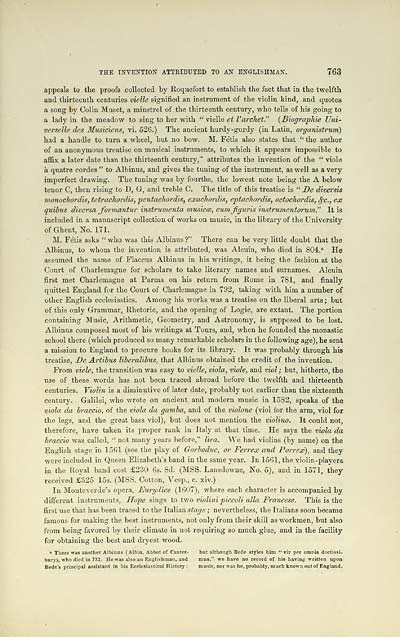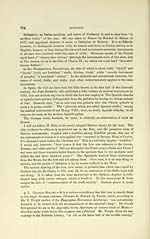Glen Collection of printed music > Printed text > Popular music of the olden time > Volume 2
(387) Page 763
Download files
Complete book:
Individual page:
Thumbnail gallery: Grid view | List view

THE INVENTION ATTRIBUTED TO AN ENGLISHMAN. 763
appeals to the proofs collected by Roquefort to establish the fact that in the twelfth
and thirteenth centuries vielle signified an instrument of the violin kind, and quotes
a song by Colin Muset, a minstrel of the thirteenth century, who tells of his going to
a lady in the meadow to sing to her with " vielle et I'arcket." (Biographie TJni-
verselle des Musicians, vi. 526.) The ancient hurdy-gurdy (in Latin, organistrum)
had a handle to turn a wheel, but no bow. M. Fetis also states that " the author
of an anonymous treatise on musical instruments, to which it appears impossible to
affix a later date than the thirteenth century," attributes the invention of the " viole
a quatre cordes " to Albinus, and gives the tuning of the instrument, as well as a very
imperfect drawing. The tuning was by fourths, the lowest note being the A below
tenor C, then rising to D, G, and treble C. The title of this treatise is " De diversis
monochordis, tetrachordis, pentaclwrdis, exachordis, eptachordis, octochordis, fyc, ex
quibus dioersa formantur instrumenta nmsicce, cumjiguris instrumentorum." It is
included in a manuscript collection of works on music, in the library of the University
of Ghent, No. 171.
M. Fetis asks "who was this Albinus?" There can be very little doubt that the
Albinus, to whom the invention is attributed, was Alcuin, who died in 804." He
assumed the name of Flaccus Albinus in his writings, it being the fashion at the
Court of Charlemagne for scholars to take literary names and surnames. Alcuin
first met Charlemagne at Parma on his return from Rome in 781, and finally
quitted England for the Court of Charlemagne in 792, taking with him a number of
other English ecclesiastics. Among his works was a treatise on the liberal arts ; but
of this only Grammar, Rhetoric, and the opening of Logic, are extant. The portion
containing Music, Arithmetic, Geometry, and Astronomy, is supposed to be lost.
Albinus composed most of his writings at Tours, and, when he founded the monastic
school there (which produced so many remarkable scholars in the following age), he sent
a mission to England to procure books for its library. It was probably through his
treatise, De Artibus liberalibus, that Albinus obtained the credit of the invention.
From viele, the transition was easy to vielle, viola, viole, and viol ; but, hitherto, the
use of these words has not been traced abroad before the twelfth and thirteenth
centuries. Violin is a diminutive of later date, probably not earlier than the sixteenth
century. Galilei, who wrote on ancient and modern music in 1582, speaks of the
viola da braccio, of the viola da gamba, and of the violone (viol for the arm, viol for
the legs, and the great bass viol), but does not mention the violino. It could not,
therefore, have taken its proper rank in Italy at that time. He says the viola da
braccio was called, " not many years before," lira. We had violins (by name) on the
English stage in 1561 (see the play of Gorbodvc, or Ferrex and Porrex), and they
were included in Queen Elizabeth's band in the same year. In 1561, the violin -players
in the Royal band cost £230 6s. 8d. (MSS. Lansdowne, No. 5), and in 1571, they
received £325 15s. (MSS. Cotton, Vesp., c. xiv.)
In Monteverde's opera, Eurydice (1607), where each character is accompanied by
different instruments, Hope sings to two violini piccoli alia Francese. This is the
first use that has been traced to the Italian stage ; nevertheless, the Italians soon became
famous for making the best instruments, not only from their skill as workmen, but also
from being favored by their climate in not requiring so much glue, and in the facility
for obtaining the best and dryest wood.
11 There was another Albinus ( Albin, Abbot of Canter- but although Bede styles him " vir per omnia doctissi-
bury), who died in 732. He was also an Englishman, and mus," we have no record of his having written upon
Bede's principal assistant in his Ecclesiastical History: music, nor was he, probably, much known out of England.
appeals to the proofs collected by Roquefort to establish the fact that in the twelfth
and thirteenth centuries vielle signified an instrument of the violin kind, and quotes
a song by Colin Muset, a minstrel of the thirteenth century, who tells of his going to
a lady in the meadow to sing to her with " vielle et I'arcket." (Biographie TJni-
verselle des Musicians, vi. 526.) The ancient hurdy-gurdy (in Latin, organistrum)
had a handle to turn a wheel, but no bow. M. Fetis also states that " the author
of an anonymous treatise on musical instruments, to which it appears impossible to
affix a later date than the thirteenth century," attributes the invention of the " viole
a quatre cordes " to Albinus, and gives the tuning of the instrument, as well as a very
imperfect drawing. The tuning was by fourths, the lowest note being the A below
tenor C, then rising to D, G, and treble C. The title of this treatise is " De diversis
monochordis, tetrachordis, pentaclwrdis, exachordis, eptachordis, octochordis, fyc, ex
quibus dioersa formantur instrumenta nmsicce, cumjiguris instrumentorum." It is
included in a manuscript collection of works on music, in the library of the University
of Ghent, No. 171.
M. Fetis asks "who was this Albinus?" There can be very little doubt that the
Albinus, to whom the invention is attributed, was Alcuin, who died in 804." He
assumed the name of Flaccus Albinus in his writings, it being the fashion at the
Court of Charlemagne for scholars to take literary names and surnames. Alcuin
first met Charlemagne at Parma on his return from Rome in 781, and finally
quitted England for the Court of Charlemagne in 792, taking with him a number of
other English ecclesiastics. Among his works was a treatise on the liberal arts ; but
of this only Grammar, Rhetoric, and the opening of Logic, are extant. The portion
containing Music, Arithmetic, Geometry, and Astronomy, is supposed to be lost.
Albinus composed most of his writings at Tours, and, when he founded the monastic
school there (which produced so many remarkable scholars in the following age), he sent
a mission to England to procure books for its library. It was probably through his
treatise, De Artibus liberalibus, that Albinus obtained the credit of the invention.
From viele, the transition was easy to vielle, viola, viole, and viol ; but, hitherto, the
use of these words has not been traced abroad before the twelfth and thirteenth
centuries. Violin is a diminutive of later date, probably not earlier than the sixteenth
century. Galilei, who wrote on ancient and modern music in 1582, speaks of the
viola da braccio, of the viola da gamba, and of the violone (viol for the arm, viol for
the legs, and the great bass viol), but does not mention the violino. It could not,
therefore, have taken its proper rank in Italy at that time. He says the viola da
braccio was called, " not many years before," lira. We had violins (by name) on the
English stage in 1561 (see the play of Gorbodvc, or Ferrex and Porrex), and they
were included in Queen Elizabeth's band in the same year. In 1561, the violin -players
in the Royal band cost £230 6s. 8d. (MSS. Lansdowne, No. 5), and in 1571, they
received £325 15s. (MSS. Cotton, Vesp., c. xiv.)
In Monteverde's opera, Eurydice (1607), where each character is accompanied by
different instruments, Hope sings to two violini piccoli alia Francese. This is the
first use that has been traced to the Italian stage ; nevertheless, the Italians soon became
famous for making the best instruments, not only from their skill as workmen, but also
from being favored by their climate in not requiring so much glue, and in the facility
for obtaining the best and dryest wood.
11 There was another Albinus ( Albin, Abbot of Canter- but although Bede styles him " vir per omnia doctissi-
bury), who died in 732. He was also an Englishman, and mus," we have no record of his having written upon
Bede's principal assistant in his Ecclesiastical History: music, nor was he, probably, much known out of England.
Set display mode to: Large image | Transcription
Images and transcriptions on this page, including medium image downloads, may be used under the Creative Commons Attribution 4.0 International Licence unless otherwise stated. ![]()
| Special collections of printed music > Glen Collection of printed music > Printed text > Popular music of the olden time > Volume 2 > (387) Page 763 |
|---|
| Permanent URL | https://digital.nls.uk/91366638 |
|---|
| Shelfmark | Glen.254a |
|---|---|
| Additional NLS resources: | |
| Attribution and copyright: |
|
| Description | Scottish songs and music of the 18th and early 19th centuries, including music for the Highland bagpipe. These are selected items from the collection of John Glen (1833 to 1904). Also includes a few manuscripts, some treatises, and other books on the subject. |
|---|
| Description | The Glen Collection and the Inglis Collection represent mainly 18th and 19th century Scottish music, including Scottish songs. The collections of Berlioz and Verdi collected by bibliographer Cecil Hopkinson contain contemporary and later editions of the works of the two composers Berlioz and Verdi. |
|---|

